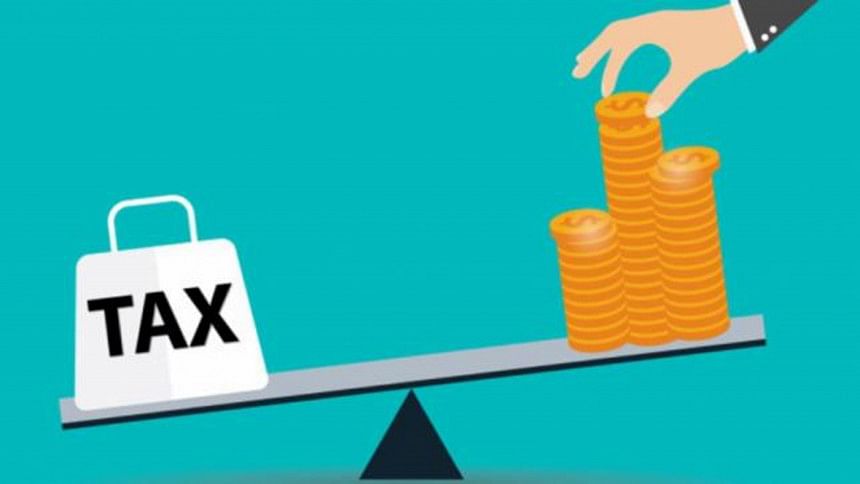Why is tax-GDP ratio so low in Bangladesh and how to raise it?

Despite positive economic growth in recent years, Bangladesh has one of the lowest tax-to-GDP ratios (9.3 percent) in the South Asian region. It is 23.1 percent in Nepal, 16.8 percent in India and 11.0 percent in Pakistan.
Income tax is one of the major components of tax revenue. Besides income tax, there are two other major sources of revenue—value added tax (VAT) and customs duty. The projection of total revenue collection from income tax, VAT and customs duty for the year 2020-21 is estimated to be Tk 378,000 crore, where the National Board of Revenue (NBR) will contribute Tk 330,000 crore. Of that, Tk 103,945 crore will come from income, profit and capital tax, while Tk 125,162 crore will be collected through VAT. Past record shows collection from VAT has always been higher than that of income tax—which puts a burden on marginalised people through double taxation and as a result, inequality has worsened over the years. At the same time, because of globalisation, both custom and import-stage supplementary duties are likely to decline in relative terms. Under the circumstances, the government is set to enhance its revenue mobilisation through income tax.
Unfortunately, in Bangladesh, a large number of individuals and firms are unregistered and the vast majority of registered individuals and firms with taxable income are not interested in paying taxes. According to a NBR study, about four crore people in the country have the capacity to pay taxes, but the majority of them do not pay tax on their income. At present, NBR has about 40 lakh registered taxpayers but only 22 lakh submitted their tax returns in FY 2018-19. The study also found that there are 213,505 companies registered with the Registrar of Joint Stock Companies (RJSC), of which about 45,000 companies submitted tax returns.
Tax evasion is a serious problem in Bangladesh—as companies with huge revenues also evade taxes. In addition, businessmen who collect VAT from consumers evade tax through under-reporting. Some of the multinational companies evade taxes through misuse of a mechanism, known as "transfer pricing". Transfer price is the price at which divisions of a company transact with each other for goods or services. It takes place when two related companies such as a parent company and a subsidiary, or two subsidiaries controlled by a common parent, engage in international trade with each other for goods and services. Sometimes, related entities of a multinational firm show artificially high prices for an imported product or service in an attempt to deflate profits and evade taxes. This practice is known as "transfer mis-pricing". According to the Global Financial Integrity Report (GFI), Bangladesh lost a staggering USD 7.53 billion on average between 2008-2017 to trade mis-invoicing during foreign commerce with its 135 trading partners (The Daily Star, March 05, 2020).
Moreover, there are some businessmen, politicians and government officials, who instead of paying taxes on their undisclosed income (legal or illegal), are taking their money and investing in commercial ventures and properties abroad. According to the GFI report released in January 2019, in 2015, USD 5.9 billion (about Tk 50,000 crore) was siphoned out of Bangladesh and a total of USD 81.74 billion went out between the years 2006-2016. The annual report of the Swiss National Bank titled "Banks in Switzerland 2019" showed that money held by Bangladeshi nationals and entities stood at 603 million Swiss francs or Tk 5,427 crore in 2019. The amount was Tk 5,553 crore in 2018 and Tk 4,329 crore in 2017, according to the report.
All these are affecting the economy—with disproportionate effects on the poor and marginalised sections of the population. Only working on serious changes in the tax system can give long-term results. Unfortunately, the NBR has neither enough manpower nor the expertise to address tax evasion of such magnitude. It is difficult for taxmen to identify the loopholes without having advance training on transfer pricing, money laundering, etc. Therefore, the government should train tax officials to hone their skills and come up with pro-people policy measures and create awareness on developing a culture of paying taxes.
Tax compliance depends on how the government perceives the social contract between itself and the taxpayers. When citizens see that the services they get from the government are less than what they pay for, i.e., the social contract is not honoured, they tend to reduce their tax compliance by not paying income taxes. This results in serious inadequacy of government funds for public utility services such as water supply, electricity, maintenance of roads and highways, healthcare, security and so on. Therefore, there is a crucial need for the government to make sure that this contract is honoured and public services are well provided for.
Also, a sizeable segment of people think that there is no level playing field when it comes to paying taxes; only some people pay taxes every year, while others, despite having taxable income, continue to evade them. Under current practices, the burden of tax lies on a limited number of persons/companies with higher marginal income tax rates; and the bulk of those paying income tax are salaried employees, whose companies are responsible for making their tax payments. Around 85 percent of income tax revenue comes from tax withheld at source. Another problem in our tax policy is the extensive use of tax exemptions, incentives and special provisions, which limit revenue collection and make the effective tax base much narrower than the standard tax regime. Generally, it is argued that widespread exemption encourages tax evasion, erodes tax equity and creates distortions in the economy. Various other tax breaks legally keep many more people off the tax rolls. Therefore, withdrawal of all sorts of tax holidays and tax exemptions from all sectors can significantly increase revenue.
The Eighth Five-Year Plan for fiscal year 2020-21 to fiscal year 2024-25 has set the target of raising the tax-GDP ratio to 14.2 percent by 2025. Raising tax-GDP ratio from the current dismal level of 9-10 percent to 14.2 percent of GDP will no doubt be challenging. But it is possible if the government overhauls the entire taxation system. The main thrust of tax policy reform is to boost up revenue mobilisation by expanding the tax base. In this connection, there are ample opportunities to increase tax revenue collection. Many economists argue that considering our socio-economic culture, the present tax structure is not suitable to attract enough people to pay taxes and as such the tax rate needs to be brought down to a level where everybody with taxable income feels comfortable to pay income tax; the tax net would then be wider. In economics, the Laffer Curve represents a relationship between government revenue raised by taxation and all possible rates of taxation. The Laffer Curve postulates that when tax rate on producer surplus approaches 100 percent, tax revenues may approach zero, since economic agents would not be left with any incentive to produce. The higher the tax rate, the higher the disincentive against tax compliance and greater the propensity to generate black money. Thus, reducing tax rates, particularly the maximum marginal rates of progressive taxes, can increase tax revenue in two ways. First, by increasing tax base and second, by increasing compliance with the tax rules.
Finally, strong institutional reform is essential to enhance the efficiency and capacity of the tax administration. Without an efficient and effective tax administration, it is almost impossible to execute the policies that are intended to enhance the volume of revenue collection to achieve the required tax-GDP ratio.
Abu Afsarul Haider is an entrepreneur. He studied economics and business administration at the Illinois State University, USA.
Email: [email protected]

 For all latest news, follow The Daily Star's Google News channel.
For all latest news, follow The Daily Star's Google News channel. 



Comments